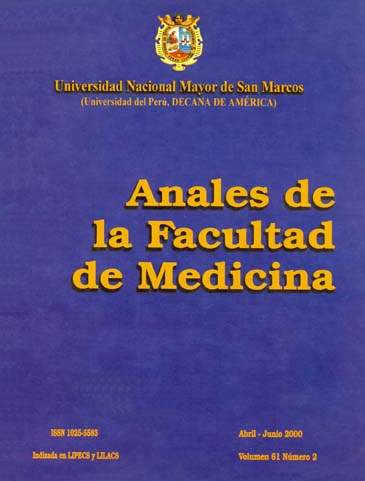Brain Neuroendoscopy: Experience in Experimental Models and Clinical Application
DOI:
https://doi.org/10.15381/anales.v61i2.4319Keywords:
Central Nervous System, Surgery, Neuroendoscopy, Brain, NeurosurgeryAbstract
OBJECTIVE: Experimental models (EM) design to acquire brain neuroendoscopy (BNE) skill to be applied on patients. MATERIAL AND METHODS: Study performed in three phases. For the first two -design and training- we used bovine and human coipses randomly assigned to groups A and B according to physiological sodium chloride solution (SCS) volume needed to produce satisfactory hydrocephalus to perform BNE. During phase three, BNE was performed in 5 patients with brain pathology confirmed by CAT or NMR. RESULTS: SCS volume needed for satisfactory BNE in the bovine EM was usually 70 mL (p< 0,01). In human EM, artifitial hydrocephalus was obtained with 150 mL of SCS (p< 0,0 l). BNE was used as a diagnostic and therapeutic tool. Post BNE complications consisted in hallucinations, fever and memory impairment, that responded well to symptomatic therapy. CONCLUSIONS: EMs designed for this study were useful tools for BNE leaming. Training in EM for BNE is essential before its application to human beings.Downloads
Published
2000-06-19
Issue
Section
Trabajos originales
License
Copyright (c) 2000 Carlos Alvarez Peña, Uldarico Rocca, Pío Rosell, Aurora Ramos

This work is licensed under a Creative Commons Attribution-NonCommercial-ShareAlike 4.0 International License.
Those authors who have publications with this magazine accept the following terms:
- Authors will retain their copyrights and guarantee the journal the right of first publication of their work, which will be simultaneously subject to Creative Commons Attribution License that allows third parties to share the work as long as its author and its first publication this magazine are indicated.
- Authors may adopt other non-exclusive licensing agreements for the distribution of the version of the published work (eg, deposit it in an institutional electronic file or publish it in a monographic volume) provided that the initial publication in this magazine is indicated.
- Authors are allowed and recommended to disseminate their work over the Internet (eg: in institutional telematic archives or on their website) before and during the submission process, which It can produce interesting exchanges and increase quotes from the published work. (See El efecto del acceso abierto ).
How to Cite
1.
Alvarez Peña C, Rocca U, Rosell P, Ramos A. Brain Neuroendoscopy: Experience in Experimental Models and Clinical Application. An Fac med [Internet]. 2000 Jun. 19 [cited 2024 Jul. 1];61(2):89-98. Available from: https://revistasinvestigacion.unmsm.edu.pe/index.php/anales/article/view/4319















